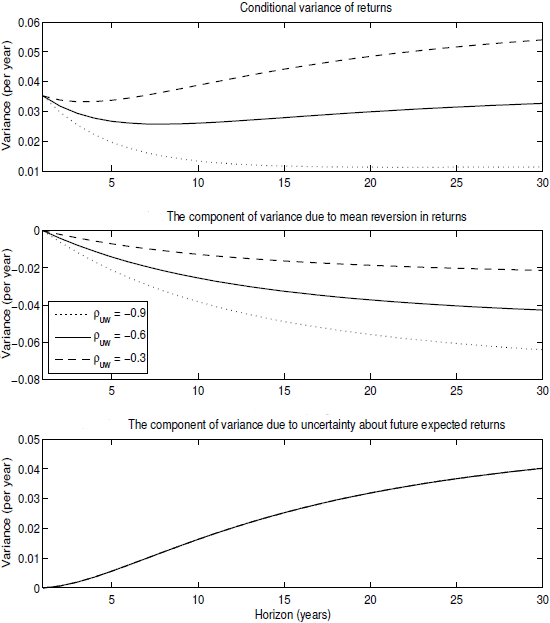The conventional wisdom is that annualized stock market volatility declines with investment horizon because of the moderating effect of mean reversion in returns. In the May 2009 version of their paper entitled “Are Stocks Really Less Volatile in the Long Run?” Lubos Pastor and Robert Stambaugh challenge this view by focusing on the reasonable expectations of investors dealing with uncertainty rather than data in hindsight. Using annual real (inflation-adjusted) returns and return predictors for the period 1802-2007 (206 years), they conclude that:
- There are five material components of equity variance as experienced by investors:
- Uncertainty in the degree to which returns are independently and identically distributed (imperfectly follow a random walk).
- Mean reversion of returns toward some long-run value (suppressing long-run variance with imperfect predictability).
- Uncertainty about future expected returns for equities (because the expected return varies with imperfect predictability).
- Uncertainty about the current expected return for equities (as imperfectly inferred from historical data).
- Uncertainty about the values of parameters used in return prediction models.
- Mean reversion strongly reduces long-horizon variance, but the other four components more than offset its moderating effect, such that the annualized 30-year variance is nearly 1.5 times the 1-year variance. Uncertainty about future expected returns makes the largest positive contribution to variance at
the 30-year horizon. (See the charts below.) - Stocks, and therefore target-date funds, may be less appealing to long-horizon investors than conventional wisdom suggests. Investors with horizons of several decades may actually prefer a lower equity allocation than investors with shorter horizons.
- Conclusions are robust to subperiods, excess versus raw returns, higher sampling frequency within subperiod and different expected return models.
The following group of three plots, taken from the paper, explores the contributions of the second and third of the five components listed above to annualized stock market variance for three different strengths of mean reversion (as measured by the correlation of past and future returns – rho) and a given degree of return predictability over investment horizons ranging from zero to 30 years.
- The first depicts the annualized expected variance based on the combined contributions from the second and third components, showing that mean reversion must be very (unplausibly) strong to keep variance at long investment horizons lower than at short horizons.
- The second shows the contribution to annualized variance from mean reversion only.
- The third shows the contribution from the strongest positive component of variance only, uncertainty about future expected returns.
As investment horizon increases, mean reversion initially exerts a stronger effect, but uncertainty about future expected returns eventually dominates for reasonable strength of mean reversion. The degree of predictability of future returns also affects expected variance. The more predictable returns are, the stronger the effects of both mean reversion and uncertainty of future expected returns, with the latter effect prevailing for long investment horizons.

In summary, evidence indicates that equity investors continuously acting on reasonable but uncertain expectations may experience much higher return volatilities over the long run than suggested by realized stock market volatility in hindsight.